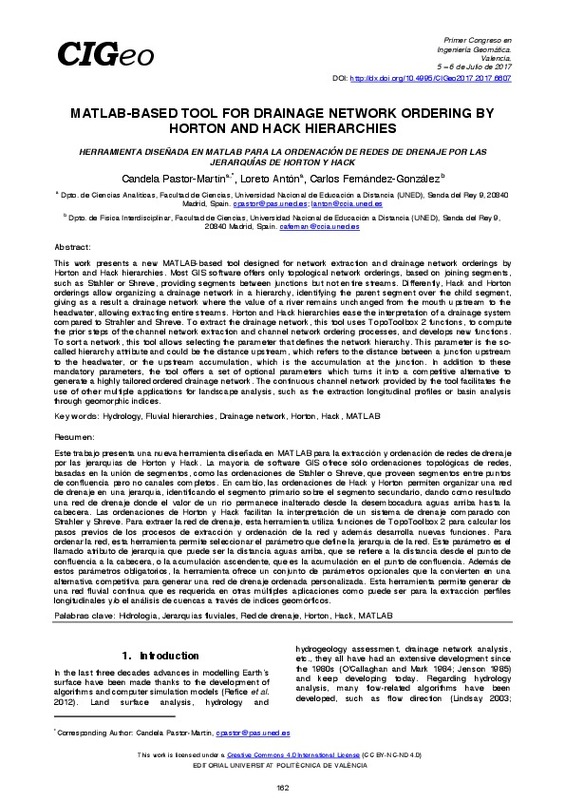|
Resumen:
|
[EN] This work presents a new MATLAB-based tool designed for network extraction and drainage network orderings by
Horton and Hack hierarchies. Most GIS software offers only topological network orderings, based on joining ...[+]
[EN] This work presents a new MATLAB-based tool designed for network extraction and drainage network orderings by
Horton and Hack hierarchies. Most GIS software offers only topological network orderings, based on joining segments,
such as Stahler or Shreve, providing segments between junctions but not entire streams. Differently, Hack and Horton
orderings allow organizing a drainage network in a hierarchy, identifying the parent segment over the child segment,
giving as a result a drainage network where the value of a river remains unchanged from the mouth upstream to the
headwater, allowing extracting entire streams. Horton and Hack hierarchies ease the interpretation of a drainage system
compared to Strahler and Shreve. To extract the drainage network, this tool uses TopoToolbox 2 functions, to compute
the prior steps of the channel network extraction and channel network ordering processes, and develops new functions.
To sort a network, this tool allows selecting the parameter that defines the network hierarchy. This parameter is the socalled
hierarchy attribute and could be the distance upstream, which refers to the distance between a junction upstream
to the headwater, or the upstream accumulation, which is the accumulation at the junction. In addition to these
mandatory parameters, the tool offers a set of optional parameters which turns it into a competitive alternative to
generate a highly tailored ordered drainage network. The continuous channel network provided by the tool facilitates the
use of other multiple applications for landscape analysis, such as the extraction longitudinal profiles or basin analysis
through geomorphic indices.
[-]
[ES] Este trabajo presenta una nueva herramienta diseñada en MATLAB para la extracción y ordenación de redes de drenaje
por las jerarquías de Horton y Hack. La mayoría de software GIS ofrece sólo ordenaciones topológicas ...[+]
[ES] Este trabajo presenta una nueva herramienta diseñada en MATLAB para la extracción y ordenación de redes de drenaje
por las jerarquías de Horton y Hack. La mayoría de software GIS ofrece sólo ordenaciones topológicas de redes,
basadas en la unión de segmentos, como las ordenaciones de Stahler o Shreve, que proveen segmentos entre puntos
de confluencia pero no canales completos. En cambio, las ordenaciones de Hack y Horton permiten organizar una red
de drenaje en una jerarquía, identificando el segmento primario sobre el segmento secundario, dando como resultado
una red de drenaje donde el valor de un río permanece inalterado desde la desembocadura aguas arriba hasta la
cabecera. Las ordenaciones de Horton y Hack facilitan la interpretación de un sistema de drenaje comparado con
Strahler y Shreve. Para extraer la red de drenaje, esta herramienta utiliza funciones de TopoToolbox 2 para calcular los
pasos previos de los procesos de extracción y ordenación de la red y además desarrolla nuevas funciones. Para
ordenar la red, esta herramienta permite seleccionar el parámetro que define la jerarquía de la red. Este parámetro es el
llamado atributo de jerarquía que puede ser la distancia aguas arriba, que se refiere a la distancia desde el punto de
confluencia a la cabecera, o la acumulación ascendente, que es la acumulación en el punto de confluencia. Además de
estos parámetros obligatorios, la herramienta ofrece un conjunto de parámetros opcionales que la convierten en una
alternativa competitiva para generar una red de drenaje ordenada personalizada. Esta herramienta permite generar de
una red fluvial continua que es requerida en otras múltiples aplicaciones como puede ser para la extracción perfiles
longitudinales y/o el análisis de cuencas a través de índices geomórficos.
[-]
|








